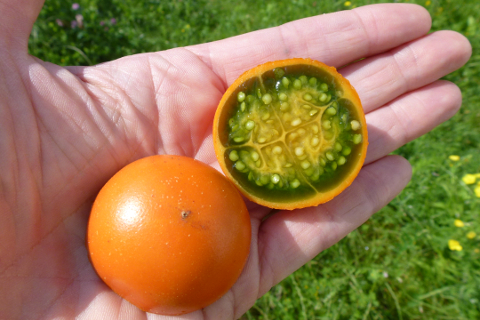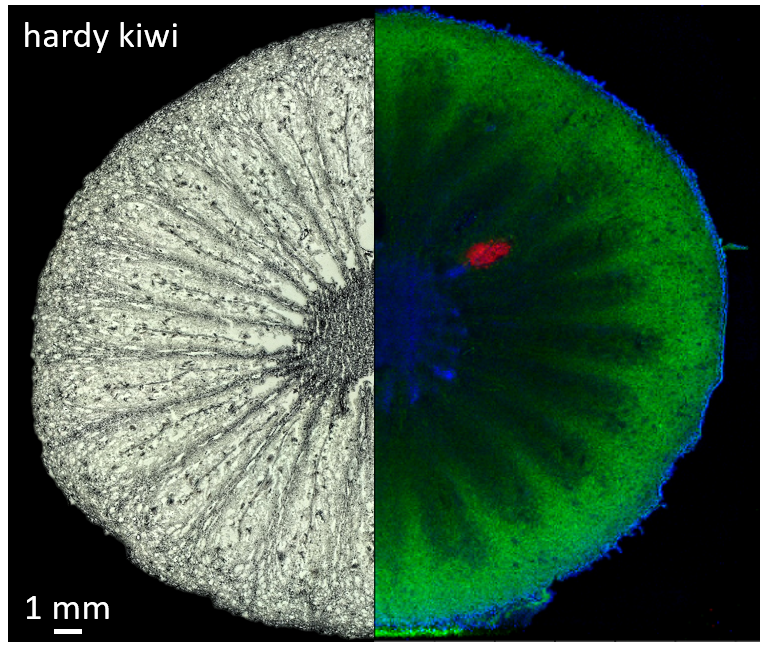Projects
Project Lulo 2020

© Dr. Marianne Lauerer
The lulo or naranjilla (Solanum quitoense) is an exotic tropical fruit from South America that is still widely unknown in Germany. However, the lulo is supposed to have great potential in the European market because of its delicious taste and nutritionally relevant ingredients. Previous investigations at the Ecological-Botanical Garden of the University of Bayreuth revealed that these exotic fruits are sensory accepted by German consumers and can be produced year-round in greenhouses.
As part of the "Lulo2020" project launched in October 2017 several lulo provenances from Central and South America will be phenotypically characterized in terms of their flower, fruit and seed properties, quantified in fruit yield and analyzed according to their physico-chemical fruit quality (e.g. sugars, acids). To evaluate the prominent colorants in the orange peel and greenish pulp of the tested provenances, we will identify and quantify the carotenoids and chlorophyll derivatives of ripe fruits by UHPLC-DAD(-APCI)-MS. In addition, suitable cultivation systems will be tested and phytomedicinal relevant pathogens will be analyzed in the seeds by molecular biological methods. The project is funded by the Landwirtschaftliche Rentenbank.
Contact: Dr. Marianne Lauerer
Project AGROR
© Rainer Sturm / pixelio.de
This project is investigating the authenticity of cereals by means of a combination of different spectrometric methods (NMR, LCMS, IRMS, as well as NIR, MIR and Raman spectroscopy) to detect profiles of ingredients and isotopic patterns. Cereal species, variety, purity of variety, origin and cultivation method shall be discriminated as far as possible using these spectrometric fingerprints. The project aims at developing high-end reference methods as well as screening methods for on-site application. NMR, LCMS and IRMS are already used as high-end methods for scrutinizing authenticity of raw materials in food industry. For example, NMR spectroscopy is used for fruit juices, wine and honey. This project examines to what extent the different methods can be established as reference methods for the authenticity of cereals alone or in combination. The methods for on-site screening are focused on the vibrational spectroscopies near infrared, mid infrared- and Raman-spectroscopy. To this end, comprehensive spectral data bases of authentic cereal samples are being established and chemometric models are calculated for the provenance of cereal crops. Another question is whether marker molecules can be derived from the profiles of ingredients and whether the chemometric models and markers can be applied to processed produces such as flour and pastries.
Contact: Prof. Dr. Stephan Schwarzinger
Project Imaging of Food

MS Imaging allows visualising the distribution of chemical components throughout the food matrix. This can be of interest when analytes are expected to be located only in particular tissue parts, e.g. only in the mesocarp or in the peel of a fruit. This project focuses on MS Imaging of processed food. Especially in processed food consisting of several ingredients, the distribution not only of endogenous compounds, such as nutrients, but also of food additives, nutrients for food fortification, contaminants or other minor components are of interest and more challenging to predict. Current work deals with the penetration of preservatives into cheese in the context of official penetration limits defined by European legislation and the investigation of nutrients’ and particularly contaminants’ distributions in processed food of plant origin in the light of mitigation methods for the reduction of contaminants in food.
Contact: Prof. Dr. Andreas Römpp
Project "Uptake, accumulation, and metabolic fate of thioarsenates in plants"
The metalloid arsenic is ubiquitous in the environment due to both natural and anthropogenically influenced processes. Arsenic is toxic to all types of organisms and for humans it is categorized as a class 1 carcinogen. Arsenic is inadvertently taken up by plants via transporters for essential or beneficial nutrients. Therefore, dietary intake of plant-derived food and especially of rice grains is a major route for human exposure to chronically toxic arsenic. Different inorganic and organic arsenic species are found in the environment. The two main inorganic As species generally considered to account for most of the As accumulation in plants are arsenate under oxidizing conditions and arsenite under reducing conditions. Also, rhizosphere bacteria can methylate arsenic and the respective organic arsenic species are taken up by plants, too. Recently, we discovered the occurrence of inorganic and organic thiolated, i.e. sulfur-containing, arsenic species under the reducing conditions of rice paddy fields. These forms typically escape routine sampling and analysis methods even though they represent a substantial fraction of total arsenic under various field conditions. Our pilot study demonstrated plant uptake of thioarsenates and respective toxicity. Given the relevance of plant arsenic accumulation for food safety, these two observations urgently demand a mechanistic understanding of thioarsenate effects on plants and the contribution of thioarsenates to the As load of plants. The proposed project aims at dissecting the uptake pathways for various thioarsenates in plants, the metabolic conversion of thioarsenates through reduction and complex formation within plant cells, the mobility of thioarsenate-derived arsenic species between plant tissues and finally the overall contribution of thioarsenate exposure to the arsenic load of plants. The two studied model systems are rice, which is also the main target organism with respect to food safety, and Arabidopsis thaliana, the plant that has enabled many of the major breakthroughs in understanding arsenic transport and metabolism. Mechanistic insights into the plant-thioarsenate interaction will enable approaches to substantially reduce the accumulation of ubiquitous arsenic in crop plants and thus the chronic poisoning of humans.
